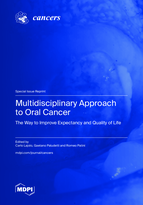Multidisciplinary Approach to Oral Cancer: The Way to Improve Expectancy and Quality of Life
A special issue of Cancers (ISSN 2072-6694). This special issue belongs to the section "Cancer Therapy".
Deadline for manuscript submissions: closed (30 April 2023) | Viewed by 25519
Special Issue Editors
Interests: Oral Potentially Malignant Disorders; Head and neck cancers; Oral Medicine and pathology; Radiotherapy; Oral and Maxillofacial Surgery; Innovative diagnostic and therapeutic devices; Osteonecrosis of the jaw
Interests: Head and neck cancers; Plastic and reconstructive surgery; Phoniatrics; Salivary gland tumors
Interests: systematic review; methodology; oral microbiome; dental diseases; regenerative medicine
Special Issues, Collections and Topics in MDPI journals
Special Issue Information
Dear Colleagues,
Among head and neck cancers, oral squamous cell carcinomas require a complex multidisciplinary diagnostic and therapeutic approach due to the complex anatomy and physiology of the affected area.
Despite the achieved improvements in the prognosis of these cancers in recent years, affected subjects suffer heavily from the side effects of therapies and their quality of life is often poor, due to functional and aesthetical impairments. In order to improve life expectancy and quality of life of these patients, a better knowledge of risk factors, biology, clinical procedures (early diagnosis, best therapeutic regimen, supportive care, and early detection of second primary cancers) are fundamental and can be enriched by a personalized medicine approach.
Areas of particular interest are prevention and early diagnosis, correct staging, and integrated clinical therapies that could improve prognosis and quality of life and supportive care.
For this Special Issue, we welcome basic translational and clinical research papers, professional opinions, and reviews in the broad field of oral cancers.
Dr. Carlo Lajolo
Guest Editor
Manuscript Submission Information
Manuscripts should be submitted online at www.mdpi.com by registering and logging in to this website. Once you are registered, click here to go to the submission form. Manuscripts can be submitted until the deadline. All submissions that pass pre-check are peer-reviewed. Accepted papers will be published continuously in the journal (as soon as accepted) and will be listed together on the special issue website. Research articles, review articles as well as short communications are invited. For planned papers, a title and short abstract (about 100 words) can be sent to the Editorial Office for announcement on this website.
Submitted manuscripts should not have been published previously, nor be under consideration for publication elsewhere (except conference proceedings papers). All manuscripts are thoroughly refereed through a single-blind peer-review process. A guide for authors and other relevant information for submission of manuscripts is available on the Instructions for Authors page. Cancers is an international peer-reviewed open access semimonthly journal published by MDPI.
Please visit the Instructions for Authors page before submitting a manuscript. The Article Processing Charge (APC) for publication in this open access journal is 2900 CHF (Swiss Francs). Submitted papers should be well formatted and use good English. Authors may use MDPI's English editing service prior to publication or during author revisions.








